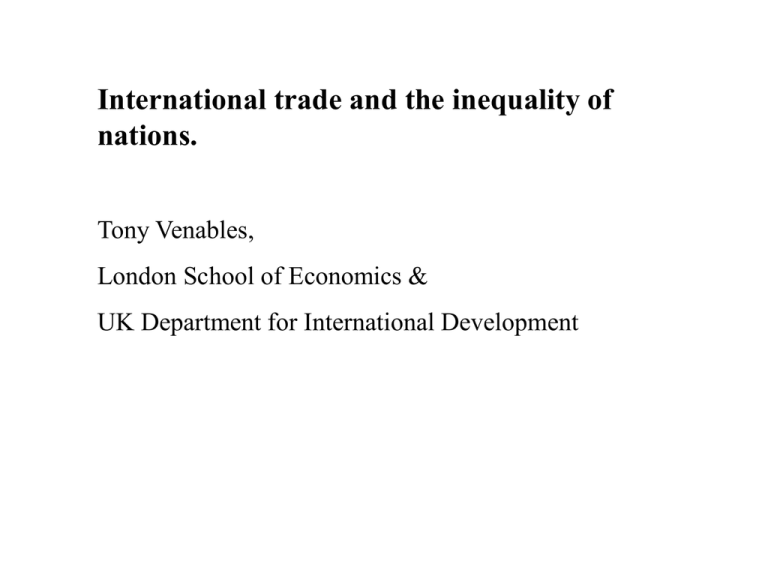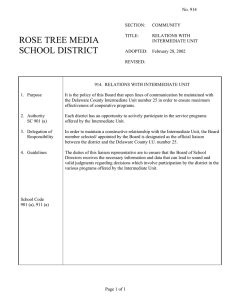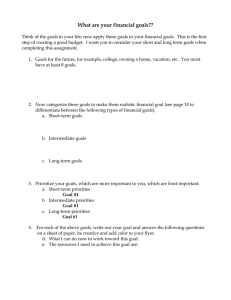Tony Venables , Chief Economist, Department for International Development. 'Convergence and Divergence in the World Economy: The Role of Trade'
advertisement

International trade and the inequality of nations. Tony Venables, London School of Economics & UK Department for International Development • Is international trade a force – for the convergence of real incomes across countries? – for the divergence of real incomes? • What is the historical record? • What does economic analysis suggest? • Is there a tension between the evidence and the theory? • Should international economics be reformulated to capture massive and persistent international inequalities? Argue that: • In different time periods and different contexts the effects of trade have been quite different. • To understand this need a theory which recognises that the productivity of labour – and hence comparative advantage – depends on inputs that are complementary with labour. • Supply of these complementary inputs is endogenous: Some are supplied publicly, some privately. They may be internationally mobile. They are often associated with cumulative causation processes. Plan of lecture • Review of evidence. • Development of simple analytical frameworks to think about the role of complementary inputs: – Capital – Institutions, infrastructure and investment climate – Intermediate goods 1: Historical record – the great divergence: • Ratio of per capita incomes of richest to poorest nations increased from around 8 in 1870 to 50 in 2000 • Decline in shipping costs and increasing role of trade Real cost of ocean shipping World merchandise exports % GDP 1790 376 1820 1% 1830 287 1870 4.6% 1870 196 1913 7.9% 1930 107 1929 9.0% 1960 47 1950 5.5% 1990 51 1973 10.5% 1998 17.2% Figure 2: Regions' share in world population 100% 80% R est W o rld B r. India Other E .A sia Japan C hina N .A merica R est W .E u UK 60% 40% 20% 0% 1820 1870 1913 1950 1998 Figure 1: Regions' share of world GDP 100% 80% Rest World Br. India Other E.Asia Japan China N.America Rest W.Eu UK 60% 40% 20% 0% 1820 Phase I 1870 1913 Phase II 1950 1998 Phase III Figure 2: Regions' share in world industrial production 100% 80% Rest World Br. India Other E.Asia Japan China N.America Rest W.Eur UK 60% 40% 20% 0% 1750 1830 1880 1913 1953 1998 Figure 4: Regions' share in world manufactured exports 100% 80% Rest World Other Asia Japan China N.America Rest W.Eu UK 60% 40% 20% 0% 1876-80 1913 1955 1997 An interpretation of the evidence: • Rich club/ poor club – ‘convergence clubs’ • Rich club has captured most of the benefits of trade. • Coexistence of these clubs for extremely long periods of time. • Economic development in sequence not in parallel NB: • Not seeking to argue that all changes in international inequality due to trade. • But, need analysis that recognises: (a) ambiguous effects of trade and (b) trade is consistent with persistent inequalities. Benchmark model: Goods: Agriculture: XA = A(LA, KA), numeraire Manufactures: XM = M(LM, KM), price p. Inputs: KA ‘Complementary input’ in agric; return rA KM ‘Complementary input’ in manuf; return rM L = LA + LM Fixed endowment of labour; wage w. Equilibrium: w = a(LA/KA) = pm(LM/KM) Also: rA = [A(LA/KA) - wLA)]/ KA rM = [pM(LM/KM) - wLM]/ KM Model I: Trade and factor flight: Capital as the complementary input. Consider a small open economy that has a comparative disadvantage in manufactures. Source of comparative disadvantage? Land abundance Technical inefficiency Complementary factor in manufactures may be internationally mobile: eg, human or physical capital. Question: What is effect of opening to trade? initial endowment K agric rm=1, autarky Ka , Km with autarky and Km mobility Ka , Km with trade and Km mobility world endowment ratio rm=1, free trade rm>1 rm<1 K manuf Trade and capital mobility in a land abundant economy Rate of return, agriculture Real wages & domestic income Autarky values =1 Rate of return, manufactures K manuf Fig xx: Factor returns relative to autarky: Ka abundant country Rate of return, agriculture Rate of return, manufactures Real wages & domestic income Autarky values = 0.95 K manuf Fig xx: Factor returns relative to rest of world: country with technical inefficiency in manufactures (10%). Key points: • Under autarky, the cost of a technical inefficiency or comparative disadvantage is spread across the entire population, via goods prices. • With trade, this cost is concentrated on owners of specific factors in the sector with disadvantage. • If this factor is internationally mobile, then this will cause capital flight and a fall in the wage. • Gain to initial residents – ‘national’ real income Loss to ‘domestic’ real income. Key points (continued): • Trade lets a country move factors out of sector with comparative disadvantage – but how are they absorbed elsewhere? Can ‘capital’ be employed elsewhere? Heckscher-Ohlin versus specific factors model. Can labour be redeployed without running into diminishing returns? • The more things are tradable the easier it is to redeploy factors from contracting sectors without running into diminishing returns. Application and policy • Lagging regions? Increased trade denudes regions of skills/ capital. • Mono-crop agriculture and import competing manufacture? • Export diversification a necessary accompaniment to import liberalization. Model II: Infrastructure and institutions: publicly provided complementary inputs. • Institutions matter – Acemoglu et al. • Institutions are a ‘complementary input’ to production. • Institutions are more important for some activities than others. ‘Countries with better contract enforcement specialise in industries that rely heavily on relationship specific investments’, (Nunn, 2005) • Investment in institutions a public good, and usually cannot be made sector specific What are these ‘institutions’? • • • Rule of law, property rights, limits to corruption Infrastructure Investment climate NB: Matter particularly for modern manufacturing exports: • Importance of reliability and quality control • Just-in-time delivery. • O-rings and supermodularity – value of a product is determined by its weakest link. • Public investments in institutions/ infrastructure/ investment climate, have properties that: i) Public goods, not easily targeted to particular sector. ii) Productivity effect varies across sectors – high in modern manufacturing? • How does the provision of these services shape trade, and how does trade shape the provision of these services? • Show that two economies that are ex ante identical can be different ex post – just one of them captures all the gains from trade. Model II: • Two sectors, A and M, as before, using labour and a public service, s. • Marginal (and average) products of labour in each sector, a(si), pm(si) • One unit of labour produces one unit of public service. In country i, if both sectors active: Labour market clearing: Real income of country i: wi = a(si) = pm(si) 1 - si = LA + LM . ui = (1 - si)wi p-μ Autarky: ui = (1 - si) a(si)1-μ m(si)μ Optimal choice of s: si /(1 - si) = (1- μ)ηA + μηM Can there be an asymmetric equilibrium? Suppose so: in equilibrium, country 1 has only manufactures; L1M = 1 – s1, w1 = pm(s1) > a(s1) country 2 has agriculture and manufactures; L2M + L2A = 1 – s1, w2 = pm(s2) = a(s2) This means that world price is, p = a(s2) /m(s2) Real income levels, u1, u2: u1 = (1–s1)w1 p-μ = (1–s1) m(s1)[a(s2) /m(s2) ]1-μ optimal choice of s1: s1 /(1 – s1) = ηM u2 = (1–s2)w2 p-μ = (1–s2)a(s2)1-μ m(s2)μ optimal choice of s2: s2 /(1 – s2) = (1- μ)ηA + μηM Optimal choice of s1 : Optimal choice of s2 : s1 /(1 – s1) = ηM s2 /(1 – s2) = (1- μ)ηA + μηM This is an equilibrium if ηM > ηA: In this case country choices imply, s1 > s2, and therefore productivity levels such that country 1 specialised in manufactures. Country 2 has no incentive to deviate. Real income levels? Country 2: No gains from trade (same choice of s2, and same prices as under autarky). Country 1: Gains from trade (higher level of s1, same prices as under autarky). The game between countries: Remove discontinuities by adding a specific factor in agriculture: a(si , LiA/KA) s1 s2 =R(s1) E Eqm where country 1 takes all the gains from trade. Compute best response functions. Multiple equilibria. E s1 =R(s2) s2 Gains/ losses from trade. Best response functions and equilibria Key points: • Economies may be identical ex ante, but asymmetric ex post, with one taking all the gains from trade. • If one country has already made the investments that give it comparative advantage in manufacturing, then it is not worthwhile for the other country to investment. • I.e., for a country with a small modern sector it is rational to invest little in the public goods that raise productivity in this sector (…..and therefore it will turn out to have a small modern sector). • Target provision of infrastructure/ institutional investments? Model III: Intermediate goods: linkages and clustering. • Third sort of complementary input: intermediate goods. • Draw on ‘new economic geography’, Fujita, Krugman & Venables. • Productivity depends on local supply of intermediates • Intermediate goods create the possibility of forward and backward linkages -- old idea from the development literature (Hirshman, Myrdal). • Forward (cost) linkages: downstream firms gain from proximity to their suppliers (eg, save transport costs). • Backward (demand) linkages: upstream firms gain from proximity to their customers (transport costs). • Can produce outcomes where activity ‘clusters’ in one country. Key assumptions to get clustering? • Many types of intermediate goods, and each type only produced in one place – presumably because of increasing returns to scale. (Without this assumption, have ‘backyard capitalism’). • Proximity advantage – eg transport costs. The model: • Agriculture: labour productivity: a(LiA) • Manufactures: Each country produces its own variety of final good, output prices = unit cost, p1, p2 (perfect competition) • Inputs to manufacturing: • Labour, with share in costs 1 – v. • Continuum of intermediate goods, share v, elasticity of substitution between intermediate varieties = 1 (CobbDouglas). • Intermediate goods can be produced in one country or the other, using just labour. Let θ denote the fraction of the types produced in country 1. • Intermediates’ prices, w + ε, transport costs t. • Final goods prices, p1 = w11-vw1vθ (w2t)v(1- θ) , p2 = w2(1-v)w2v(1- θ) (w1t)vθ Price of final goods produced in country 1, country 2; p1 = w1[1-v(1-θ)] (w2t) v(1-θ), p2 = w2[1-vθ] (w1t)vθ Demand for final goods from both countries, exports have transport cost ; X1= D(p1, p2+) + D(p1+, p2), X2 = D(p2, p1+) + D(p2+, p1) yi is quantity of each variety of intermediate produced in country i. Derived demand for intermediate goods (in value terms); w1y1θ = θv(p1X1+p2X2/t), w2y2(1- θ) = (1- θ)v(p2X2+p1X1/t). Each variety of produced in country from which it makes largest total sales, i.e. θ adjusts until y1 = y2. How does varying the location of intermediate good production change profitability, y1, y2? Increase θ implies ↓p1 and ↑p2. • Crowding effect: Given X, if more locally supplied then each sold in smaller quantity. Depends on value of t. • Cost/ sales effect: Reduction in p1 expands sales, X1, and hence increases y1. Depends on values of t and . • Will get clustering of activity if cost/ sale effect dominates crowding. t = 1.7 t = 1.58 y1 y2 y1 y2 t = 1.1 t = 1.55 y1 y2 y1 Trade liberalisation causes concentration of activity y2 , share of intermediate production in country 1 Stable eqm Unstable eqm = 1 = 1/2 = 0 Trade costs Spatial bifurcation Summary: • At high trade costs, each country has industry to supply local consumers – crowding effect dominates cost/sales expansion effect. Symmetry, θ = ½. • At intermediate trade costs, sales more responsive to cost differences – cost/ sales effect dominates. Agglomeration, θ = 1 or θ = 0. So far, assumed wages fixed: what if they respond to employment levels (upward sloping labour supply curve from other sectors)? t = 1.52 t = 1.7 y1 y1 y2 y2 t = 1.4 y1 t = 1.1 y2 y1 y2 Divergence and convergence , share of intermediate production in country 1 = 1 Stable eqm Unstable eqm = 1/2 = 0 Trade costs The tomahawk: Spatial bifurcation with wage flexibility Real wages 1, 2 1 1 = 2 2 Trade costs Real wages, if country 1 has the cluster Cut trade costs: – deindustrialises 2 & cuts its real wage – globalization phase, rapid catch up by 2, possible fall real wage in 1. Summary – the general theory of location: • At high trade costs: location determined by demand: θ = ½. Equal real wages. • At intermediate trade costs: location determined by clustering forces: θ = 1 or θ = 0. Real wages unequal. • At low trade costs: location determined by factor costs θ = ½. Equal real wages. • Implications for real wages and the distribution of the gains from trade. • In multi-country setting, have ‘rich club’ / ‘poor club’. Extensions – other clustering mechanisms: • ‘Timeliness’ as a trade cost: (Harrigan & Venables) • One assembly plant in each country. • Range of intermediate goods, each type produced in just one country. • Probability of remotely produced int. arriving on time, q < 1. • Probability of all ints. arriving on time for plant in country 1 is q1-θ, where θ is no. of intermediates prod. in 1. • This probability is increasing and convex in θ. • If delaying production is costly, then it is efficient to put all intermediate production next to one assembly plant – ie., clustering. Timeliness: • Intermediate producers cluster, because it is better to have one assembly plant working well and the other badly, than both ‘1/2 well’ V1 + V 2 V2 Arrival time uncertainty V1 • Intuition – if one part is delayed, matters less that second is also delayed. Extensions: • Other clustering mechanisms? • Thick labour markets -- matching -- skill acquisition • Knowledge spillovers. • What is their interaction with trade? Trade liberalization facilitates clustering – all the way to free trade (i.e., not tomahawk case)? • What is their spatial scale? Urban rather than international economics? Conclusions: • Need to recognise that trade has not always brought a balanced distribution of benefits. • Have offered some reasons why this is so – organised around the theme of the supply and/or location of complementary inputs to production. • Absolutely NOT a rejection of the case for trade liberalization; many of these models yield much larger world gains from trade liberalisation than do standard models. BUT: Recognise that opening to trade can create problems. • Alternative employment of resources displaced from import competing sector may mean lower income. Even in a ‘perfect’ economy, trade can increase incentives for factor flight and redeployed labour may run into diminishing returns and lower wages. Need more tradable goods – diversification (Model I) • Incentives to improve institutions and the investment climate may be low. Need cost effective ways to target these expenditures. Aid for trade. (Model II) • Small trade frictions combined with ‘linkages’ mean that large wage differences are not enough to attract industry. But optimistic message – globalization reduces the value of proximity and facilitates relocation of stages of the production process. (Model III)

